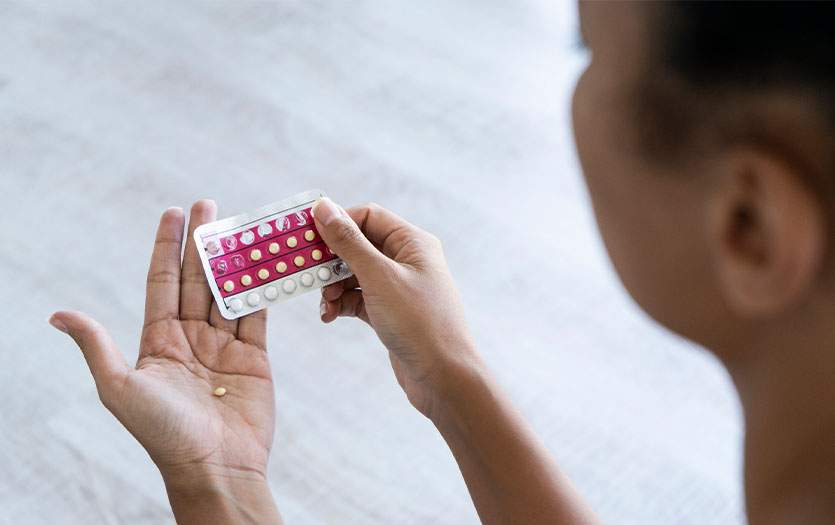
This post was written by Dr. Jake Rosner, PPG – OBGYN.
Beyond their primary function of preventing pregnancy, various traditional birth control methods offer significant benefits in treating and managing numerous gynecologic conditions. Many women silently endure these conditions, often unaware that practical solutions exist through these readily available medications. To help you distinguish between the contraceptive aspect of these treatments and their therapeutic advantages, we'll explore their other most common applications.
Heavy periods
Menorrhagia is a condition in which menstrual bleeding is heavier or lasts longer than usual. You may pass large blood clots and have to change pads or tampons often. Or your periods may last longer than 7 days.
The hormonal IUD is often the most effective medical treatment for heavy periods. This small T-shaped device releases a continuous, low dose of the hormone levonorgestrel.
Here's how it works:
-
Endometrial thinning: Levonorgestrel acts directly on the uterine lining (endometrium), causing it to become very thin and "atrophic." This leaves very little tissue to shed during menstruation, which drastically reduces blood loss.
-
Decidualization of the stroma: The hormone induces changes in the cells of the endometrial lining, a process called decidualization, which further suppresses its growth and development.
-
Ovulatory suppression: While not its primary method for treating menorrhagia, a hormonal IUD can suppress ovulation in some women, which also contributes to lighter periods.
Combined hormonal contraceptives
CHCs are another option for managing heavy bleeding. They contain a combination of the hormones estrogen and progestin (synthetic progesterone). They are available as pills, a patch or a vaginal ring.
This is what happens in the body:
-
Ovulation suppression: The estrogen and progestin in CHCs suppress the release of gonadotropin-releasing hormone (GnRH) from the hypothalamus, which in turn inhibits the pituitary gland from releasing follicle-stimulating hormone (FSH) and luteinizing hormone (LH). This prevents the development and release of an egg (ovulation).
-
Endometrial atrophy: The progestin component induces a constant, progestogenic effect on the endometrium. This creates a thin, stable lining that is less likely to break down excessively and shed during the menstrual cycle.
-
Stabilization of the endometrium: The estrogen component helps provide stability to the endometrial lining, which can minimize the breakthrough bleeding and spotting that are sometimes associated with progestin-only methods.
-
Increased clotting factors: Estrogen also improves the blood's clotting factors, which can help to slow and reduce menstrual blood flow.
Extended or continuous cycle pills are combined hormonal pills that reduce or eliminate the placebo (inactive pill) days to suppress menstruation further. By eliminating the hormone-free interval, these pills prevent the withdrawal bleed that normally occurs during the placebo week. For some, reducing the frequency of the hormone-free interval can also alleviate symptoms like menstrual migraines and dysmenorrhea.
Progestin-only contraceptives
These methods contain only progestin and are an alternative for women who cannot take estrogen. The Depo-Provera® (contraceptive injection) and Nexplanon® (contraceptive implant) are both potent and long-acting doses of progestin. "Mini pills", a low-dose oral progestin-only pill, are typically not recommended for menorrhagia due to their association with irregular and unpredictable bleeding. However, higher doses of oral progestins are often used for shorter-term management.
These function by causing:
-
Endometrial atrophy: The progestin causes the uterine lining to thin and mature, preventing the excessive buildup that leads to heavy bleeding.
-
Reduced blood vessels: Progestins have been shown to reduce the density of blood vessels in the endometrium, further decreasing the potential for blood loss.
-
Ovulation inhibition: Depending on the dose and type of progestin, it can also inhibit ovulation, though this is not the primary mechanism for treating menorrhagia.
Acne
For some, combined oral contraceptives can be an effective treatment for hormonal acne by regulating those that cause breakouts. The estrogen and progestin in these methods work together to reduce acne by suppressing the androgens (male hormones) that can cause excess oil (sebum) production. Progestin-only birth control methods, such as the mini-pill, implant or hormonal IUD, may actually worsen acne.
Historically, some combination birth control pills have been approved by the U.S. Food and Drug Administration (FDA) specifically for treating acne. Yaz® and Beyaz® contain drospirenone and ethinyl estradiol. The progestin drospirenone has anti-androgenic effects, making it particularly effective for acne.
Other pills with similar ingredients may also be effective in managing acne symptoms, but these have not undergone specific testing for acne treatment.
Polycystic ovary syndrome
PCOS is a hormone disorder in which the ovaries fail to release eggs regularly. This condition causes cysts to develop on the ovaries. Symptoms of PCOS include irregular periods, excessive growth of body hair, acne and painful periods. Hormonal birth control can reduce the level of androgens that cause PCOS.
Combined hormonal contraceptives containing estrogen and progestin are a first-line treatment for PCOS. It is available in several forms, including combined pills, progestin-only options, patches and rings. The best method depends on an individual's specific symptoms, health profile and personal preferences. Always consult a healthcare provider for personalized recommendations.
Here's how it works:
-
Regulates menstrual cycles: CHCs provide regular, predictable periods for those with irregular or absent menstruation.
-
Lowers androgen levels: Estrogen suppresses the production of androgens, which can improve symptoms like hirsutism (excess hair growth) and acne.
-
Protects the uterus: Regular shedding of the uterine lining lowers the risk of endometrial cancer, a risk factor associated with PCOS.
Premenstrual symptoms comprising PMS and PMDD
Typically, the body's natural levels of estrogen and progesterone rise and fall throughout the menstrual cycle. For individuals sensitive to these hormonal shifts, this can trigger or worsen premenstrual syndrome (PMS) and premenstrual dysphoric disorder (PMDD) symptoms.
Combined oral contraceptives can help manage PMS by stabilizing these fluctuations. The effectiveness of this method can vary by the pill's formulation and dosage regimen, with some options showing better results for severe symptoms like those associated with PMDD.
While all COCs attempt to stabilize hormones, specific formulations and regimens have shown better results for premenstrual symptoms. Pills containing drospirenone, like Yaz and Beyaz, are the only oral contraceptives specifically FDA-approved to treat PMDD. Beyaz is a similar formulation that also contains folic acid.
Drospirenone is a unique type of progestin with anti-mineralocorticoid properties, which can help counteract water retention and bloating. It also has anti-androgenic effects that may have a positive influence on mood. The standard Yaz regimen, with 24 active pills and four placebo pills, creates a shorter hormone-free interval, reducing the hormonal fluctuation that triggers symptoms.
Here's how COCs can help:
-
Suppressing ovulation: By preventing the release of an egg, COCs block the significant hormone surges that happen in a natural cycle, which helps reduce symptoms.
-
Providing steady hormone levels: The pills deliver consistent doses of synthetic estrogen and progestin, "flattening out" the hormone peaks and valleys that can cause mood swings and other symptoms.
-
Creating a predictable cycle: Many people find that the regular, predictable "withdrawal bleed" that occurs during the placebo week is less intense than a natural period, with fewer associated physical and emotional symptoms.
Endometriosis
Endometriosis is an estrogen-dependent, chronic inflammatory condition in which tissue similar to the uterine lining grows outside the uterus. While combined oral contraceptives do not cure endometriosis, they can effectively manage symptoms like pelvic pain and heavy, painful periods.
COCs work by regulating hormone levels to suppress the menstrual cycle and counteract the effect of estrogen on endometriotic lesions.
This is how they treat endometriosis:
-
Suppressing ovulation: By preventing the monthly release of an egg, COCs inhibit the natural cycle's hormonal fluctuations that stimulate the growth of both the uterine lining and endometriotic implants.
-
Creating a thinner uterine lining: The constant dose of synthetic hormones in COCs causes the endometrium to become thinner and less active, resulting in lighter periods. This effect also extends to the endometriotic implants, which are similar in structure to the endometrium.
-
Reducing menstrual bleeding: With less tissue to shed each month, COCs lead to lighter and shorter withdrawal bleeds, thereby reducing the painful inflammation that accompanies menstruation for people with endometriosis.
Readdressing preconceived notions
When considering contraceptives for pregnancy prevention or other approved indications, it's natural to have questions about safety and efficacy. Here are a few popular myths that often circulate in conversations regarding these treatments.
Is it safe to skip periods with birth control pills and rings?
It is safe to skip your period if you use birth control pills or a vaginal birth control ring. A common concern among patients is that the uterine lining will "build up," but this is not true. These birth control methods thin the uterine lining, leaving nothing to shed. Historically, monthly periods were not the norm for most women due to frequent pregnancies or breastfeeding.
How often can I skip my period?
There are no strict rules about how many periods you "should" have. To prevent pregnancy, you must use active birth control pills or a vaginal birth control ring continuously for at least three weeks each month.
You have the flexibility to:
-
Use active birth control pills or a ring 365 days a year.
-
Skip periods for several months and then choose to have one.
-
The frequency of your periods may depend on whether you experience breakthrough bleeding or spotting. While this is not a sign of a health or birth control issue, it can be inconvenient.
It's possible to skip periods for years without breakthrough bleeding. However, some light bleeding or spotting is common when skipping periods for several months. By experimenting with different intervals, you can discover what works best for your body to avoid breakthrough bleeding.
Will continuous birth control use impact my fertility?
Using birth control pills or rings continuously does not impair your ability to get pregnant. Your fertility returns as soon as you stop using these methods. However, it's important to remember that fertility naturally declines with age. Therefore, if you use birth control for many years, any difficulty conceiving later will be due to aging, not the birth control itself.
Final thoughts
The silent burden of gynecologic conditions underscores the importance of a broader understanding of birth control's utility. Healthcare providers and patients alike should recognize that these medications are not solely for family planning but serve as valuable tools in women's health management, offering relief and improved well-being for a wide array of conditions. Open dialogue about these additional uses is essential to ensure women receive comprehensive care and are aware of all available treatment options.
Keep in mind, while many medications have benefits beyond their primary purpose, health insurance coverage for these uses may vary. It's wise to speak with both your provider and insurance carrier to confirm your coverage before starting treatment.
Dr. Rosner provides full-service OBGYN care and delivers at Parkview Regional Medical Center. To learn more about women's healthcare at Parkview, visit our website here.



